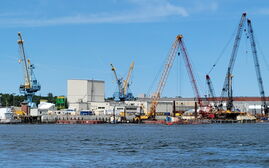Processing Your Payment
Please do not leave this page until complete. This can take a few moments.
- News
-
Editions
-
- Lists
-
Viewpoints
-
Our Events
-
Event Info
- Business Leaders of the Year Reception 2025
- Women's Leadership Forum 2025
- On the Road with Mainebiz in Bethel
- Health Care Forum 2025
- On The Road with Mainebiz in Greenville
- On The Road with Mainebiz in Waterville
- Small Business Forum 2025
- Outstanding Women in Business Reception 2025
- On The Road with Mainebiz in Bath
- 60 Ideas in 60 Minutes Portland 2025
- 40 Under 40 Awards Reception 2025
- On The Road with Mainebiz in Lewiston / Auburn
- 60 Ideas in 60 Minutes Bangor 2025
Award Honorees
- 2025 Business Leaders of the Year
- 2024 Women to Watch Honorees
- 2024 Business Leaders of the Year
- 2023 NextUp: 40 Under 40 Honorees
- 2023 Women to Watch Honorees
- 2023 Business Leaders of the Year
- 2022 NextUp: 40 Under 40 Honorees
- 2022 Women to Watch Honorees
- 2022 Business Leaders of the Year
-
-
Calendar
-
Biz Marketplace
- News
- Editions
- Lists
- Viewpoints
-
Our Events
Event Info
- View all Events
- Business Leaders of the Year Reception 2025
- Women's Leadership Forum 2025
- On the Road with Mainebiz in Bethel
- Health Care Forum 2025
- On The Road with Mainebiz in Greenville
- + More
- On The Road with Mainebiz in Waterville
- Small Business Forum 2025
- Outstanding Women in Business Reception 2025
- On The Road with Mainebiz in Bath
- 60 Ideas in 60 Minutes Portland 2025
- 40 Under 40 Awards Reception 2025
- On The Road with Mainebiz in Lewiston / Auburn
- 60 Ideas in 60 Minutes Bangor 2025
- - Less
Award Honorees
- 2025 Business Leaders of the Year
- 2024 Women to Watch Honorees
- 2024 Business Leaders of the Year
- 2023 NextUp: 40 Under 40 Honorees
- 2023 Women to Watch Honorees
- 2023 Business Leaders of the Year
- + More
- 2022 NextUp: 40 Under 40 Honorees
- 2022 Women to Watch Honorees
- 2022 Business Leaders of the Year
- Nomination Forms
- Calendar
- Biz Marketplace
Regional approach needed to maintain shipyard workforce
 Photo / Jim Neuger
Portsmouth Naval Shipyard, which dates to 1820, has 6,450 employees and reported a total economic impact of $751.8 million in 2017.
Photo / Jim Neuger
Portsmouth Naval Shipyard, which dates to 1820, has 6,450 employees and reported a total economic impact of $751.8 million in 2017.
The Seacoast Shipyard Association is seeking to increase partnerships with schools to develop potential workers for the Portsmouth Naval Shipyard.
According to a report by the Portsmouth Herald that was published in the Bangor Daily News, the association’s members traveled to York County Community College’s tech center in Sanford to discuss workforce development. The shipyard is looking to hire 800 more employees in fiscal year 2018.
Lee Kassler, chairman of the college’s precision-machining-technology program, said 25,000 to 35,000 employees are needed in the United States to operate computer numerical control equipment. But on average, the country is graduating fewer than 400 qualified students annually.
In April, the Seacoast Shipyard Association, whose stated mission is "to protect the Portsmouth Naval Shipyard from closure," reported that the Kittery shipyard's total economic impact in 2017 was $751.8 million. That includes a total payroll of $525.2 million for 6,450 employees.
By state, that payroll breaks down to 3,679 employees from Maine, 2,333 employees from New Hampshire, 179 employees from Massachusetts and 259 from other states. The association’s annual report showed the shipyard's 6,450 employment level in 2017 continued an upward trend since 2014, with the previous three years being 5,585 employees in 2014, 6,099 employees in 2015 and 6,329 employees in 2016.
John Joyal, chairman of the Seacoast Shipyard Association, told the Portsmouth Herald that the association will be reaching out to local high schools and vocational schools to highlight career options at Portsmouth Naval Shipyard for students after they graduate.
Shipbuilding firms face shortage of skilled workers
According to a 2017 industry report by The Dwight D. Eisenhower School for National Security and Resource Strategy National Defense University Fort McNair, in Washington, D.C., many shipbuilding firms report a shortage of skilled tradespeople, such as welders, electricians and pipe fitters, despite attractive wages of over $20 per hour, with medical and leave benefits.
“The shortages have not yet caused firms to miss production deadlines, but with fewer young people taking up these trades, the workforce is aging, and managers worry about both immediate and long-term labor supply,” the report says. “Several firms have partnered with local high schools, colleges, and municipalities to offer training and apprenticeship programs, in part to make up for declining high school shop classes and vocational education as more students are steered toward college.”
Today’s U.S. shipbuilding industry consists of about three dozen firms, producing over a thousand major commercial and defense vessels (over 50 feet in length) each year, the report says.
Another dozen or so major shipyards perform only repair and conversion work. The industry generates roughly $26 billion in revenue annually, employs more than 100,000 workers, and grew by 1.6% per year in fiscal years 2011-2016.













Comments